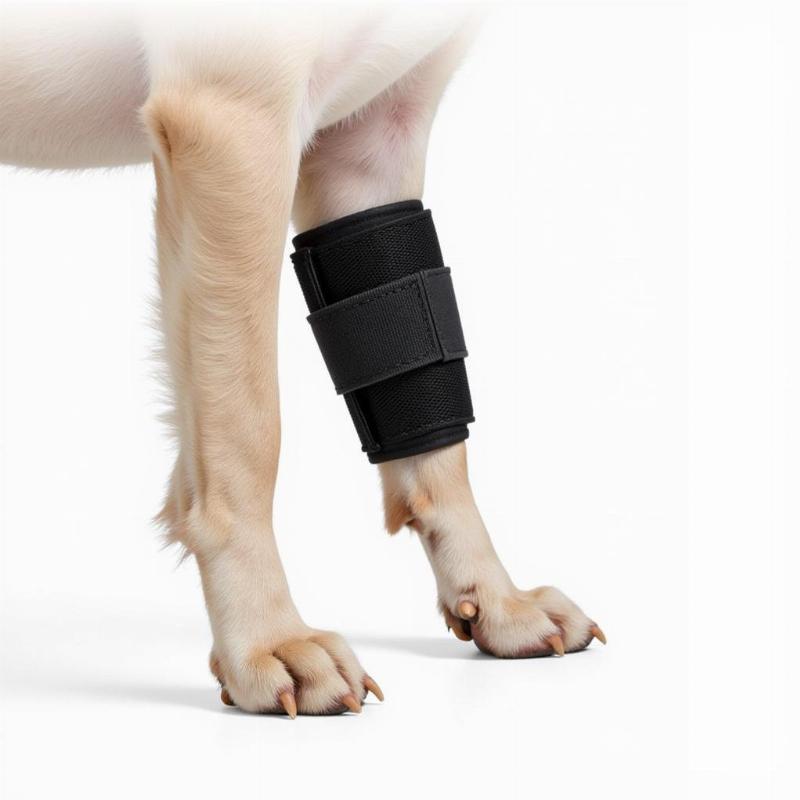No chew wraps for dogs are a popular solution for pet owners looking to protect their belongings and prevent destructive chewing. But are they the right choice for your furry friend? This guide explores everything you need to know about no chew wraps, from how they work to safety considerations and alternative solutions.
Understanding the Need for No Chew Wraps
Dogs chew for a variety of reasons, including teething, boredom, anxiety, and even just plain enjoyment. This natural behavior can, however, lead to damaged furniture, destroyed shoes, and even potential health hazards if your dog ingests something they shouldn’t. No chew wraps aim to address this issue by physically preventing the dog from accessing areas they might otherwise chew on. They can be especially helpful for dogs recovering from surgery or injuries, preventing them from licking or biting at bandages or stitches.
Types of No Chew Wraps and How They Work
There are several different types of no chew wraps available, each designed for specific purposes:
- Neck Wraps: These are designed to prevent dogs from licking or biting at wounds or hot spots on their body. They are typically made from soft, comfortable materials and fasten securely around the dog’s neck.
- Leg Wraps: These are used to deter dogs from chewing on bandages or stitches on their legs or paws. They are similar to neck wraps but are designed to fit snugly around the leg.
- Body Wraps: For more extensive coverage, body wraps can be used. These are usually made of a lightweight, breathable material and can cover a larger area of the dog’s body.
 Chó đeo băng bảo vệ chân
Chó đeo băng bảo vệ chân
These wraps work by creating a physical barrier. The dog is still able to move and function normally but is prevented from accessing specific areas. It’s important to remember that no chew wraps are not intended to be a long-term solution but rather a temporary aid.
Safety Considerations and Best Practices
While no chew wraps can be helpful, it’s crucial to use them safely and responsibly:
- Proper Fit: A properly fitted wrap is essential. It should be snug but not too tight, allowing for comfortable breathing and movement.
- Supervision: Never leave your dog unsupervised while wearing a no chew wrap. Regularly check the wrap for any signs of damage or discomfort.
- Material: Choose a wrap made from breathable, non-toxic materials. Avoid wraps with small parts that could be chewed off and ingested.
- Underlying Cause: Address the underlying cause of the chewing behavior. Is your dog teething? Bored? Anxious? Providing appropriate chew toys, mental stimulation, and addressing any underlying anxiety can help reduce the need for a no chew wrap in the long run.
Alternatives to No Chew Wraps
No chew wraps are not always the best solution. Consider these alternatives:
- Chew Toys: Providing a variety of engaging chew toys can redirect your dog’s chewing behavior onto appropriate objects.
- Training and Behavior Modification: Working with a certified dog trainer can help address the root cause of the chewing behavior.
- Mental Stimulation: Keeping your dog mentally stimulated with puzzles, games, and regular exercise can reduce boredom and prevent destructive chewing.
- Bitter Apple Spray: This deterrent spray can be applied to furniture and other items to discourage chewing.
Conclusion
No chew wraps can be a useful tool for managing destructive chewing in dogs, especially in short-term situations. However, it’s vital to prioritize safety, address the underlying cause of the chewing, and consider alternative solutions whenever possible. By understanding your dog’s needs and providing appropriate outlets for their natural behaviors, you can create a happy and harmonious environment for both you and your furry friend.
FAQs
- How long can a dog wear a no chew wrap? A dog should only wear a no chew wrap for short periods under supervision. Extended use can lead to discomfort and skin irritation.
- Are no chew wraps cruel? When used correctly and for short durations, no chew wraps are not cruel. However, they should never be used as punishment or a long-term solution.
- What if my dog still chews through the wrap? If your dog chews through the wrap, discontinue use and consult with your veterinarian or a certified dog trainer.
- Can I use a no chew wrap on a puppy? Yes, no chew wraps can be used on puppies, especially during teething, but extra caution and supervision are required.
- What are some good alternatives to no chew wraps? Chew toys, training, mental stimulation, and bitter apple spray are all good alternatives.
- Where can I buy a no chew wrap for my dog? No chew wraps are readily available at pet stores, veterinary clinics, and online retailers.
- My dog seems anxious when wearing the wrap. What should I do? If your dog exhibits signs of anxiety, remove the wrap and consult with your veterinarian or a certified dog trainer.
Related Articles
Beautdogs.us is your trusted source for all things dog-related in the US. We offer expert advice on dog breeds, care, and products. Whether you’re a new dog owner or a seasoned pro, Beautdogs.us provides comprehensive and engaging content to help you navigate the joys and challenges of dog ownership. Contact us today for all your dog-related needs! Email: [email protected], Phone: +1 501-555-7529 Visit Beautdogs.us for more information.